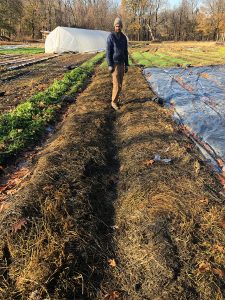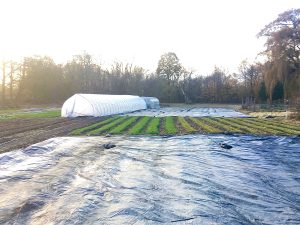Bulletin #1075, Tarping in the Northeast: Farmer Case Studies
Table of Contents
- Earth Dharma Farm ME — Stale Seedbedding with Tillage and Tarps
- Colfax Farm MA — Breaking Ground: Bringing Sod into Production and No-till Bed Management with Tarps
- Edible Uprising Farm NY — Overwintering Tarps: Cover Crop Based Tarping with Minimum Till
- Evening Song Farm VT — Cover Crop-based Rotational No-till with Tarps
- Frith Farm ME — High Input No-Till Permanent Raised Beds
- The Farm Between VT — Breaking Sod and Weed Management in Perennial Fruit Crops with Tarps
Earth Dharma Farm ME — Stale Seedbedding with Tillage and Tarps
Farm Information

- Farmers: Dave McDaniel and Heather Selin.
- Farm Name: Earth Dharma Farm.
- Location: Jackson, ME.
- Total Acres and Crops Produced: On their 182-acre farm, there are 160 acres of managed woodlot, 7.5 acres of hay, 2 acres of vineyard, 1.5 acres of mixed vegetables. The primarily marketed vegetable crops include spinach, tomatoes, peppers, eggplants, and garlic.
- Soil Type and Water Dynamics: Very well-drained, sandy loam. However, previous to Dave and Heather purchasing the land, much of the topsoil was removed during stump removal.
- General Equipment Use: 32 HP Kubota for breaking sod, primary (subsoiler, disk harrow), and secondary tillage (Kuhn 5’ tiller).
- Field Layout: Earth Dharma Farm is set up with permanent beds where possible. However, there is ledge that makes it tough to make long contiguous stretches. Plots are 50’ x 100’ long (1/10 acre) for most fields. Beds are 5’ on center with 42” bed tops.
Tarping Goals and System
- Goals of Tarping: In 2015, Dave attended various workshops and lectures by Brian O’Hara, Ray Archuleta, and Mark Hutton that all pointed him in the direction of using tarping to reduce tillage and control weeds. The weed seedbank on the farm was so bad that they were ready to abandon certain crops such as spinach. Dave looks at tarping as an integral tool to reduce soil disturbance, therefore building soil organic matter, and leaving weed seeds buried. It has also been critical to reduce the weed pressure and allow for successful production of spinach and garlic crops.
- Early Uses of Tarps: Their early goal with tarping was to fully eliminate tillage. In the first season, Dave picked up two odd-shaped bunker tarps. He cut a few to 32’ x 100’ then cut others for individual beds. One piece was cut too short, leaving 8 bed feet untarped. Despite flame weeding that untarped section 3 times, the tarped section was significantly less weedy. The next year Dave went all in.
- Current Crops and Systems: When Earth Dharma Farm started transitioning to using tarps, they were highly diversified. So much so that Dave was concerned about the profitability of many of their enterprises. While transitioning to fitting tarps into the rotation, it was an ideal time to scale back and focus on fewer crops. Now Dave preps beds in the fall, tarps overwinter, then direct seeds spinach into those tarped plots. Tarps are also used to prepare beds for garlic with minimum tillage.
One piece was cut too short, leaving 8 bed feet untarped. Despite flame weeding that untarped section 3 times, the tarped section was significantly less weedy. The next year Dave went all in.
Tarp Details and Management
- Years Tarping: 5 (Started tarping in 2016).
- Source of the Tarps and Lifespan: Paris Farmers Union. Two of their tarps are 5 years old, two are 4 years old, and two are 3 years old. If tarps are kept in full pieces and mice, deer, and goshawks are managed, Dave believes that you could easily get 6-10 years out of these tarps. (While Dave appreciates the goshawks controlling rodents, their talons did a number on one of his tarps one season).
- Tarp Material: 6 mil white on black silage tarp. Tarps are used black side up.
- Tarp Size: Tarps are kept in 50’ x 100’ sheets.
- Securing Method: Dave started using sandbags, but didn’t like the additional use of plastic. Now they utilize 16” x 8” x 8” cinder blocks every 6’ and have t-posts along the entire edge. They don’t put anything in the middle of the tarps.
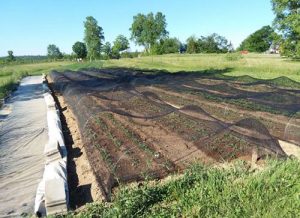
Storage: Throughout the season, the tarps are folded down the field a few beds at a time. By the end of the season, the tarps are rolled up, parallel to the bed at the bottom of the field. They will usually leave them there in a “sausage roll.” Occasionally they would fold it a few times but they have found that when the tarps are less folded, they’ve had reduced rodent presence and damage.
Specific Applications and Management
- Fitting Tarps into the Rotation: Dave uses tarps to prepare spinach throughout the season and for garlic beds. They also use them for the mixed veg homestead use plot. He aims to get the tarps down at least 1 month prior to seeding. In early seeding plots, the tarps go on as soon as the snow is off.
- Pre-tarping Practices: For garlic beds, Dave mows the summer cover crop, spreads compost that they make on the farm, shallowly tills to incorporate the amendments and form beds, then tarps for at least 4 weeks. For early spring spinach plantings, they prepare and amend those beds in the fall with compost additions, then Dave puts down the tarps either overwinter or as soon as the snow is off of the fields in the spring.
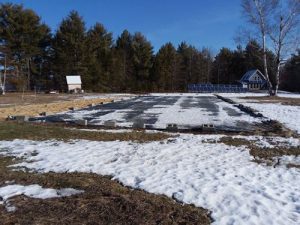
Timing and Duration: Summer crops and garlic plots are tarped for at least 3 weeks but ideally 4. In the early spring, tarps are applied when the last snow is off the field. At this point in the season, 6 weeks is the minimum that Dave would leave the tarps on due to the short days and cool temperatures. In his system of slowly rolling the tarps back, bed by bed with every 10-day succession planting, he sees significantly better weed control with his second, and especially his third and onward successions.
Takeaways, Mistakes, and Big Wins
He has effectively controlled “12 of his 14 weed species” with tarps. That means that he still has issues with crabgrass and lambsquarters. So, while tarping has significantly reduced weeding labor needs, and helped improve soil health, it isn’t a complete silver bullet. It requires a different level of management.
- Failures, Unintended Consequences, and Adjustments: Dave gives the practice of tarping a solid ‘B’ rating. It’s a solid tool that fits in well with commercial vegetable rotations, especially with our cold New England spring soils. He has effectively controlled “12 of his 14 weed species” with tarps. That means that he still has issues with crabgrass and lambsquarters. So, while tarping has significantly reduced weeding labor needs, and helped improve soil health, it isn’t a complete silver bullet. It requires a different level of management.
- Measures of Success: The reduced weed pressure has allowed Dave to continue and expand his spinach market, which he was ready to walk away from prior to tarping. Being able to direct seed has greatly reduced labor and inputs, resulting in increased profitability of that enterprise. Dave has also seen improved soil health due to the reduction in tillage.
- Future Experimentation and Adjustments: Dave and Heather are planning to try some different approaches to manage crabgrass. Potentially tarping for 2 or 3 weeks, removing the tarp for 5 days, then reapplying. They may also try removing the tarp 2 weeks prior to seeding the crop and flaming the bed prior to seeding.
- Lessons Learned: Tarps need to be taken care of to be effective. Prevent deer from walking over the tarp and tearing it, and use rodent deterrents.
- Advice for New Tarpers: Don’t cut your tarps too small. Working with larger sheets is more efficient, easier to hold down, and holds heat better. Start small and see what works for your system.
Dave and Heather are planning to try some different approaches to manage crabgrass. Potentially tarping for 2 or 3 weeks, removing the tarp for 5 days, then reapplying. They may also try removing the tarp 2 weeks prior to seeding the crop and flaming the bed prior to seeding.
Colfax Farm MA — Breaking Ground: Bringing Sod into Production and No-till Bed Management with Tarps
Farm Information
- Farmer: Molly Comstock.
- Farm Name: Colfax Farm.
- Location: Alford, MA.
- Total Acres and Crops Produced: 3 acres in mixed veg production and expanding.
- Soil Type and Water Dynamics: Well drained river valley silt loam.
- General Equipment Use: The tractor is used only for breaking ground by moldboard plowing then rototilling. After the initial opening of the sod, all management is done with hand tools: Broadfork, Jang, and Earthway.
- Field Layout: Each field section contains 12 to 15 beds each with 30” wide bed tops x 100’ long. It takes 3 tarps to cover 1 section.
Tarps hold beds between crops, help residue decay, and also cover beds that have gotten real weedy that they can’t deal with at the time.
Tarping Goals and System
- Goals of Tarping: At the farmland, Molly was on before her current location, she used conventional tillage (plowing, discing, rototilling beds) and lots of plastic mulch. Weeds were out of control and they were concerned about the farm’s productivity, degrading soils, and sustainability. Molly sees tarps as a bed saver and weed suppressor and has used them to help move the farm towards practically zero tillage. Tarps hold beds between crops, help residue decay, and also cover beds that have gotten real weedy that they can’t deal with at the time.
- Early Uses of Tarps: When opening new ground at the new farm in 2017, Molly used a moldboard plow, followed by the tractor-mounted rototiller to incorporate and break up the sod. After tilling the crew would apply the tarp to help break down the sod and flush weeds out of that newly opened ground.
- Current Crops and Systems: Since that time, tarping has become more of a bed preparation tool to kill crops and decompose residue over a 3 to 4 week tarped window before planting the following crop. They have also recently tried breaking new ground with only tarps, and no tillage. This involves applying the tarp over old hay ground, leaving it for an entire year, and then no-till planting a cover crop (cereal rye) directly through the tarped zone in the late fall.
Tarp Details and Management
- Years Tarping: 4 seasons — since 2017.
- Source of the Tarps and Lifespan: Ground cover tarps from Rainflow have held up since initially purchasing them in 2017.
- Tarp Material: Woven (polypropylene) fabric.
- Tarp Size: 12’ x 100’ long.
- Securing Method: 11” ground staples.
- Storage: Tarps are folded, and stored in the field. They have not had any rodent problems from this approach.
Specific Applications and Management
- Fitting Tarps into the Rotation: Tarps are used throughout the growing season. All direct seeded crop beds get tarped prior to seeding (carrots, beets, salad greens, etc.) For most transplants, tarps have, or get holes burnt into them for planting into and they are left in place throughout the growing season. Molly incorporates the time needed for tarping into her planning, especially for crops that can have the biggest weed issues.
- Pre-tarping Practices: Tarps are typically applied directly over crop residue from the previous crops without tillage. For example, in Mid-June prior to Fall Carrots, tarps go directly over crop residue of the April-planted mustard greens, radish, and turnip crops. If larger, stalky brassicas were there prior to tarping, the stalks are cut below the soil surface.
- Timing and Duration: Tarps are typically left on the field for 1 month between crops.
- Post-Tarp Crop Establishment and Management: After removing the tarp in July, the crew will rake the beds to remove residue, if needed, broadfork, add amendments (Krehers or compost, see below), and often just rake to smooth. They then plant carrots. After the carrot harvest, they often reapply tarps overwinter, and plant greens (e.g. spinach) in spring.
- Amendments Critical to the System: Molly and the farm crew apply ten 5-gallon buckets of compost per 2.5’ wide by 100’ long bed. That’s about 15-20 tons per acre per year.
- Labor Demands of the System: Molly prefers woven fabric tarps to silage tarps because she finds them easier to move and secure. Molly and members of the crew can do it themselves if they need to, and it’s really easy with two people. It takes 20 minutes to move tarps and staples from one spot to the next. The crew is moving tarps all the time, 2-3 per week. If weeds get out of control and “beds are going to be a nightmare” they just tarp it and hold it. They are always moving tarps across the farm. This system “adds flexibility, saves beds.”
- Material and Equipment Modifications: Molly is still looking for the right tool for very shallow tillage when they need it. A tilther hand tool worked at first but didn’t hold up with the residue and soil conditions. They are currently sticking with a landscape rake, which gets the job done.
Takeaways, Mistakes, and Big Wins
- Failures, Unintended Consequences, and Adjustments: Colfax Farm still has some problem weeds, primarily nutsedge, in both beds and pathways. They also have a lot of rodent activity under the tarps, and are hoping for predators! When nutsedge was really bad after spring brassicas, they just tarped that plot and kept it on for the season, choosing to not plant until the following year.
- Measures of Success: Soils: In fields that have been tarped the longest (3 years) they are finding that broadforking is not necessary as things are loosening up. They note that the “soil is a pleasure to work in” and less physically challenging to work. They are avoiding compaction from tractors and the lack of tractors in the system allows for just “ humans in the space,” where the field feels like a natural space to be. Pests: They have significantly less weed pressure. Nutsedge and galinsoga are still big problems; however, the overall weed pressure is significantly reduced due to the tarping. Labor: Molly appreciates the flexibility that tarps offer, knowing beds are covered, and not feeling the pressure to deal with weedy beds before they set seed — just tarp it.
- Future Experimentation and Adjustments: Molly would like to trial different approaches and adjustments to get better control of weeds that are surviving the tarping. Potentially watering before tarping, flaming, or other ways to get on the weeds.
- Advice for New Tarpers: “Staple it to keep it down! Don’t think you’re not going to have weeds. It’s not magic, but it is magic! Sometimes the soil is so nice.”
In fields that have been tarped the longest (3 years) they are finding that broadforking is not necessary as things are loosening up. They note that the “soil is a pleasure to work in” and less physically challenging to work.
Edible Uprising Farm NY — Overwintering Tarps: Cover Crop Based Tarping with Minimum Till
Farm Information
- Farmers: Ben Stein and Alicia Brown.
- Farm Name: Edible Uprising Farm.
- Location: Troy, NY.
- Total Acres and Crops Produced: Edible Uprising Farm intensively manages 1 acre to produce mixed vegetables, herbs, and cut flowers.
- Soil Type and Water Dynamics: Very well-drained sandy loam.
- General Equipment Use: Ben and Alicia utilize a BCS rotary plow for paths and building beds, a BCS precision depth roller set shallow, and a 40 HP Kubota with bucket.
- Field Layout: 12 plots that are 60ft wide x 50ft long. Each plot is made up of 15 permanent beds, which are 4’ on center with 30” bed tops.
Tarping Goals and System
- Goals of Tarping: Ben and Alicia’s main goal on the farm is to keep the ground covered and use tarps along with mulch and cover crops to do that. Their objectives with tarping are to:
- Terminate cover crops, like winter rye in the spring, prior to anthesis.
- Regulate soil moisture to optimize planting windows (protect from storms). For example, fall prep beds and tarp overwinter for early spring planting.
- Protect soil when mulching or cover cropping is not an option.
- Break ground with minimal tillage.
- Reduce weeds with minimal labor input (only 2 full-time crew).
- Early Uses of Tarps: Edible Uprising Farm broke ground in their first year without access to a tractor or equipment. Instead, they used tarps to break down perennial cover. The land was a hayfield prior to them jumping in that spring. They mowed the field, laid out blocks, rotary plowed, tarped for 3 weeks, rotary plowed again, tarped, then formed beds. They made the decision to get into the land quickly and had mixed results, mostly due to the tarps needing to be on longer. That year was a “weeding nightmare,” except where they tarped for 4 months before fall planting, where it worked beautifully.
- Current Crops and Systems: Some of the systems that tarps accommodate are killing overwintered cereal rye and preparing for no-till direct seeding cucurbit and tomatoes. Also, terminating successions of greens, and preparing beds for early small seeded crops.
Tarp Details and Management
- Years Tarping: 3 years — started in 2018.
- Source of the Tarps and Lifespan: 3 years so far, still using original tarps acquired in 2018.
- Tarp Material: 5 mil polyethylene silage tarps.
Tarp Size: Various sizes are used to fit different applications. They started with three 32’ x 100’ tarps and one very large tarp (400’ x 60’), acquired from a neighboring dairy farm, that was cut down to size. Now they have one 50’ x 60’ sheet to cover whole plots, two ½ block pieces that are 50’ x 30’ each, and two 10’ x 50’ pieces to cover two beds at a time and make them more flexible. All tarps are and need to be a couple of feet wider than the bed width.
Specific Applications and Management
- Fitting Tarps into the Rotation: Tarps are left on the plots overwinter for the earliest planted crops like onions and greens. Beds seeded to cereal rye get tarped in spring prior to planting cucurbits and tomatoes, which serves to terminate the cereal rye cover crop. Tarps are also used by the farm to hold beds after summer cover crops, like buckwheat, until seeding fall crops or cover crops.
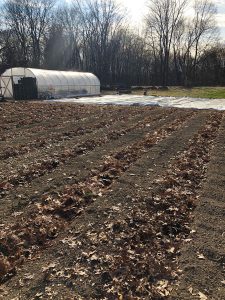
Pre-tarping Practices: Between mid-September and mid-November, Ben and Alicia shape beds and amend with the annual application of compost (see ‘Amendments’ below). Rye is then broadcasted by hand on the bed tops only, at a rate of about 4 gallons of seed per 50’ x 60’ block), followed by a pass with the precision depth roller. The paths are mulched with leaves. In the spring, they mow the rye when it’s knee high although this may not be needed.

Post-Tarp Crop Establishment and Management: After removing the tarp, Ben and Alicia transplant into the soil. If needed, they will make a furrow with a hoe first. However, the tilth of the soil is good enough that they often do not need to work the soil to facilitate transplanting. They also lay drip tape on the soil surface when transplanting. For their early spring plantings, they have to plan out what plots will be utilized for those crops the fall before, and apply tarps in fall to hold those beds. For onions, Ben and Alicia apply compost and krehers to the beds and leaves in the path in the fall. They then use a precision depth roller to incorporate that material into the top couple inches, and tarp. In the spring they pull back the tarp, broadfork if needed as there can be compaction, rake it out, and plant.
The main reason Edible Uprising does bed prep and tarps in the fall is to relieve the spring workload. Prepping beds in the spring was a huge workload and doing as much as possible in the fall helps.
Takeaways, Mistakes, and Big Wins
- Failures, Unintended Consequences, and Adjustments: While minimal, Ben and Alicia have found some compaction in the overwintered beds. This is easily counteracted by broadforking if needed. They have never needed to broadfork the rye planted plots. With the high amount of dairy-based compost additions, their phosphorus levels are very high. They are trying to adjust their compost source to get more leaf-based compost and rethink the overall fertility program. Tarps slipping out of the sandbags in the winter is another hurdle; they are planning to just add more sandbags for future overwintered applications. In a colder spring, they took the tarps off of the rye to find it still alive despite the transplants being ready to go into the ground. Finally, rodents and grub populations are very high and are attributed to the use of tarps. Hopefully Yuki the farm dog can keep the voles in check.
- Measures of Success: Adjusting the time crunch — due to this being the only system used at this property, it is hard to compare what the land could produce without tarps. However, weed management, particularly after a cereal rye cover crop, has been great. They typically just need one quick pass with the colinear or stirrup hoe per crop. The main reason Edible Uprising does bed prep and tarps in the fall is to relieve the spring workload. Prepping beds in the spring was a huge workload and doing as much as possible in the fall helps.
- Future Experimentation and Adjustments: Last spring Edible Uprising decided to plant a couple beds to peas/oats. They let that grow until mid-May, then weed whacked the plot, and tarped two 10’ x 50’ beds for 3 weeks. They are still tweaking this variation on the full winter cereal rye system.
- Lessons Learned: Most of the failures and runaway problems that they expressed were due to not leaving the tarps on for long enough. They are also improving how they seal tarp edges to keep the tarp down. This is particularly important with small tarps. Standardized sizes are really important, making sure that tarps fit your blocks and beds. Make sure to always include a little extra length to account for the raised beds and overhang for sandbags and securing.
- Advice for New Tarpers: “Recognize your goals and follow through. Don’t be afraid to try tarping winter rye even if the rye is not at full size. We’ve seen benefits from rye even if planted late. One part of the problem is not getting the rye seeded early enough in fall, like October into early Nov. Our goal is not to maximize productivity (on each square foot of land). If it was then we wouldn’t do it this way.”
Standardized sizes are really important, making sure that tarps fit your blocks and beds. Make sure to always include a little extra length to account for the raised beds and overhang for sandbags and securing.
Evening Song Farm VT — Cover Crop-based Rotational No-till with Tarps
Farm Information
- Farmers: Ryan and Kara Fitzbeauchamp.
- Farm Name: Evening Song Farm.
- Location: Shrewsbury, VT.
- Total Acres and Crops Produced: 4 acres of mixed vegetables with 3 High Tunnels.
- Soil Type and Water Dynamics: Somewhat poorly drained, rocky silty loam with a hardpan about 18” down. Much of the farm is on a 4 to 8% slope. They have installed swales every 40’ down the slope to slow and divert water.
- General Equipment Use: 45 HP tractor for field operations and a BCS with power harrow which is mostly just for use in the high tunnels.
- Field Layout: Most of the plots on the farm are 40’ x 120’ long. Beds are semi-permanent: since each field is limited to 40’ wide, wheel tracks remain consistent from one year to the next. Bed tops are 4’ wide.
Tarping Goals and System
- Goals of Tarping: Tarps allow them to achieve complete kill of seed setting weeds that mowing or tilling doesn’t completely kill. The new layout of their plots to accommodate tarping also allows for better water management. Tarping has allowed them to reduce tillage, ultimately improving soil structure. A goal of the no-till rolled rye-vetch plots is to grow N to reduce imported nutrients, however, they are still working on making that goal a reality.
- Early Uses of Tarps: Early uses of the tarps involved putting tarps down to prepare the first planting of greens and again between successions of greens. At that point, they were growing in permanent beds with permanent sod pathways which complicated tarp placement and use.
- Current Crops and Systems: In addition to the greens successions, late season crops like cucurbits and fall brassicas have worked well in the high residue cover crop no-till tarped system.
Tarp Details and Management
- Years Tarping: 4 years — since 2017.
- Source of the Tarps and Lifespan: They are still using their initial tarps from Nolts Greenhouse Supplies
- Tarp Material: Black Ultraweb polypropylene tarps (landscape fabric, however it is lighter weight than traditional landscape fabric).
- Tarp Size: 40’ x 120’ long
- Securing Method: Sandbags are used. The spacing depends on the season and windiness. During the main season bags are placed every 8’ on the edges, and every 15’ in the middle. More are used for overwinter and spring (windy season) applications.
- Storage: Tarps are stored rolled up into tubes. Ryan has noticed that rodents are really attracted to this roll, but hasn’t figured out a good way to deter them. Some tarps have gotten holes chewed through, but these small holes don’t easily get ripped larger and the tarps still work effectively with some holes.
Three 20” wavy coulters are pulled through the residue to mark rows and loosen a slot to plant, and fall brassica and cucurbit transplants are put in.
Specific Applications and Management
- Fitting Tarps into the Rotation: Ryan and Kara’s high residue cover crop tarping system requires more planning, for tarping in the rotation. Traditionally, they would mow and incorporate a cereal rye cover crop between mid-May to mid-June, followed by multiple passes of a chisel plow and rototiller to sufficiently incorporate the residue. With tarping, the cover crop may be rolled and tarped as early as June 1, with two weeks of tarping necessary to sufficiently terminate the cover crop. Planting occurs from June 15 through early August.
- Pre-tarping Practices: After planting a cereal rye / hairy vetch mix in September of the year before, they use a tractor bucket floating on the ground to flatten the cover crop in early to mid-June of the following spring. At that point in the year there is substantial growth of the cover crop, so getting that knocked down and in closer contact with the soil is key. The tarp is pulled over the cover crop immediately after knocking it down.
- Timing and Duration: In year one of trialing managing cover crop residue with tarps, they used a clear plastic tarp for the first week. This killed the cover crop, but not the germinating summer annual grass weeds. They swapped that out for the black woven tarp for another week and a half and got excellent control of the weeds. Ten days of tarping with a woven black tarp is sufficient to kill the cover crop, but longer tarp applications tend to correlate with better weed suppression.
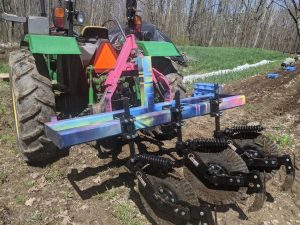
Post-Tarp Crop Establishment and Management: After removing the tarps from the high residue system in July, Ryan will broadcast pelletized fertilizer over the surface of the residue and soil. Three 20” wavy coulters are pulled through the residue to mark rows and loosen a slot to plant, and fall brassica and cucurbit transplants are put in. They attempted to plant directly into the soil, but the compaction created very slow transplanting conditions.
The uniform dimensions of their plots allow for easier rotation and eliminate the need to sift through different sized tarps.
Takeaways, Mistakes, and Big Wins
- Failures, Unintended Consequences, and Adjustments: Ryan and Kara are working on figuring out nitrogen and fertility issues related to the compost source they are using. Where fertilizer is not incorporated in the high residue system, they are interested to see how that affects availability. These systems also affect the ease and speed of transplanting. Due to transplanting being slowed so much in the first year of the system, crew morale was low. If the plot was any bigger it would have worn on spirits. The implementation of the coulter strip-tiller has sped up the process to be comparable in ease to a fully tilled system.
- Measures of Success: They have seen big improvements to soil structure from their amendment additions as well as the big reduction in tillage. On sloping soil, it is highly advantageous to have a cropping system that reduces tillage and can accommodate very high levels of residue on the soil surface. The reduction in labor spent on weed management, paired with equal or higher crop yields show a real potential for elevated profitability with this system. Ryan and Kara also use tarps in a minimum till system for greens succession plots and have found the best weed control is achieved by preparing beds at least three weeks in advance of planting, tarping for about two weeks, uncovering the tarp, leaving the soil for 10 days, and flame weeding immediately before seeding.
- Future Experimentation and Adjustments: Ryan and Kara are thinking about planting sudangrass in the late summer to facilitate early spring tarping and no-till planting for earlier season crops. They are also considering mounting a drop spreader on the coulter toolbar to apply fertilizer directly in the row, rather than broadcast over the field.
- Lessons Learned: While these systems can make good progress at addressing production problems associated with excessive tillage on small-acreage systems it still has some drawbacks. Perennial weeds need particular attention in reduced tillage systems. They can become particularly problematic if they are not controlled before seeding the rye-vetch cover crop. The benefits of the high-residue no-till system may be diminished with high weed seedbanks, as mechanical cultivation is not an option. Having straw mulch ready to spread if weeds are germinating has proved to be effective. They have also had to adjust and get creative to overcome transplanting concerns due to compaction. Their creativity and adaptability have allowed them to make these simple adjustments to make the system work.
- Advice for New Tarpers: “Just try on a 1/10 acre and see how it goes. Start small and give it a shot. Grow some rye, tarp, and throw in some fall brassicas.”
They have seen big improvements to soil structure from their amendment additions as well as the big reduction in tillage. On sloping soil, it is highly advantageous to have a cropping system that reduces tillage and can accommodate very high levels of residue on the soil surface.
Frith Farm ME — High Input No-Till Permanent Raised Beds
Farm Information
- Farmer: Daniel Mays.
- Farm Name: Frith Farm.
- Location: Scarborough, ME.
- Total Acres and Crops Produced: 3 acres of mostly mixed organic vegetables with some herbs, flowers, and fruit.
- Soil Type and Water Dynamics: Very flat, loamy sand with a seasonal high water table. Wet in the spring, droughty mid-season. After many seasons of intensive purchased compost, leaf mulch, and cover crop applications, they are mostly utilizing built soil over the native soil.
- General Equipment Use: Mostly human power. A 35 hp tractor with a loader, primarily only used to load wheelbarrows and to pull a subsoiler and a bush hog for field edges. A BCS is the primary tool for growing areas with a flail mower and rotary plow for opening fields and making raised beds. They also use a weed wacker, riding lawn mower, and many hand tools.
- Field Layout: The farm is divided into 16 plots, each one being 12 permanent beds that are 5’ on center x 100’ long. One-third of the farm is cover cropped each year for some duration. Depending on the plot that may just be for the fall or spring.
Tarping Goals and System
- Goals of Tarping: Daniel uses tarps primarily as a termination strategy for crops, cover crops, and weeds. He appreciates the efficacy of tarps as a tool for managing beds without tilling and tillage equipment. The tarps function as a reset or pause button as opposed to constantly chasing after weeds. They also function as a placeholder; when the beds are not being cropped, tarps hold nutrients and suppress weeds. After significant additions of amendments to build soil since the inception of the farm, the farm has mostly buried their weed seed bank. This, in combination with tarping, creates a very clean environment. What weeds do show up are easily pulled by hand.
- Early Uses of Tarps: Early on, tarping on Frith Farm was used as an emergency response, pausing weed growth. It was less a part of the full crop plan and just plugged in where weeds were getting out of control. They were not connected to cover crop management at all.
- Current Crops and Systems: Tarps are now used as a central component of the soil health plan on the farm. Tarps are utilized between plantings of salad greens to disrupt weed and crop growth, as well as to terminate cover crops, without disturbing soil. The current system goes far beyond the early approach of just trying to maintain a semblance of control.
Tarps are now used as a central component of the soil health plan on the farm. Tarps are utilized between plantings of salad greens to disrupt weed and crop growth, as well as to terminate cover crops, without disturbing soil.
Tarp Details and Management
- Years Tarping: 7 years – since 2014.
- Tarp Material: Initially, the farm had invested in 11-millimeter (mil) used billboard tarps. After the National Organic Program (NOP) disallowed the use of polyvinyl chloride (PVC) materials, the material used to make billboard tarps, Daniel switched to 6 mil polyethylene silage tarps, black side up.
- Source of the Tarps and Lifespan: He sources these new tarps from Johnny’s Selected Seeds. He has used both styles of tarps for 3 years each and neither has begun to break down. Crop stubble can be a concern, particularly if you walk over the tarp. There are some small holes appearing, mostly from rodent damage during storage.
- Tarp Size: 24’ x 100’ sheets cover four 5’ wide beds at a time. The raised beds and excess on either edge for securing the tarps requires a few extra feet.
- Securing Method: Each tarp section gets 30 8” x 8” x 8” concrete blocks. They stack well in storage, grab the tarp well, and last forever. Daniel is not a fan of sandbags due to how annoying the filling process is, how the plastic degrades, and the fact that they don’t stack easily.
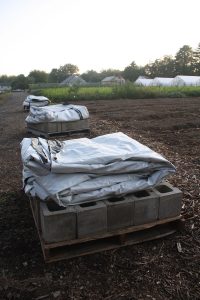
Tarp Storage: Daniel has a system of palletized tarp “kits”. On each pallet, they stack the 30 concrete blocks followed by the folded 24’ x 100’ tarp. Those pallets are stored outside.
Specific Applications and Management
- Fitting Tarps into the Rotation: There are two distinct ways that the farm uses tarps. The first is between successions of salad greens. The tarp is added to the field for between one day (during hot long days) to a week to kill crop residue and weeds, and to prepare the bed for the next succession without tillage. Successions are planted every week for greens. Having plots next to each other allows the crew to just drag the tarp sideways to the next set of beds. Tarps are also used to terminate overwintered cover crops, usually cereal rye in late May or early June. Two to three weeks of tarping leaves a nice mulch to transplant through. The tarp durations are scheduled into the crop rotation plan.
- Pre-tarping Practices: After a light spring application of fertilizer for salad greens, future successions are not fertilized. That early fertilizer is broadcasted and raked in, or buried with an inch or two of bark mulch. Bed prep for the overwintered cover crop fields involves raising the beds as needed prior to planting rye, however that is usually only done every 4-5 years. Fertilizer is applied before seeding fall cover crops.
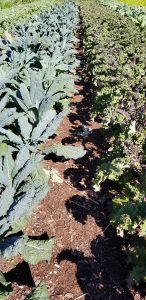
Amendments Critical to the System: Early on, compost was critical. Now that nutrient levels (specifically phosphorus) are elevated, sifted bark mulch is used as a mulch that can be seeded into directly. Other mulches used include leaves, straw, peat moss, and wood chips. Organic fertilizer is also applied according to a soil test.
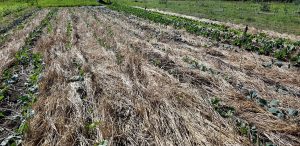
Post-Tarp Crop Establishment and Management: Daniel is both transplanting and direct seeding in this system. When transplanting, they remove the tarps and plant through remaining residue. If fertility is needed, it is added in each planting hole at transplanting. Even with the very high organic matter levels and soil friability, transplanting through the rye can be tough and slower than bare soils. They use a broadfork as a dibbler, inserting it parallel to the beds in the planting rows to make transplanting easier and faster. Direct seeding is done with an Earthway Seeder. If there is minimal residue, they will seed right into it. If they’re going into a high residue bed, the crew will rake the residue out of rows and into the walkways. In higher residue beds they will increase the seeding rate of the next crop to get the desired germination.
Daniel prefers to knock down the cover crop to get the tarp closer to the soil. To accomplish this, he has developed a human powered “walker crimper” by tying ropes to either end of a t-post….” The crew “step(s) on the post in unison with each step, in effect knocking and crimping the cover crop.
Takeaways, Mistakes, and Big Wins
- Failures, Unintended Consequences, and Adjustments: The primary issue has been dealing with rainwater on the tarp when moving or folding the tarps. In order to remove the water and move the tarps, space is needed on at least one side of the plot. They have found that flipping the tarp the 100’ length is longer to walk but results in less water weight being moved at once and better drainage into the pathways instead of over beds. Nutrient loading has also become apparent with the high level of amendments. Daniel is cutting back on compost and fertility additions, and keeping a close eye on phosphorus and pH levels moving forward.
- Measures of Success: Soils are a primary indicator of success with this system. Daniel does soil tests annually, carefully watching organic matter levels in particular. He has also seen tactile improvements in the feel of the soil, and ease of operations such as pulling root crops. Pests are another key factor. They do not leave tarps in the field overwinter, primarily to avoid creating rodent habitat. Despite the low weed populations on the farm, they have noticed that certain weed species such as sheep sorrel and most perennial weeds are not effectively controlled with tarping. Based on the reduced labor needs, reduced weed populations, improved management and utilization of intensive cover cropping, and increased yields, Frith Farm directly attributes an increased profitability to their use of tarps.
- Future Experimentation and Adjustments: The current system is working and Daniel feels as if they have worked out most of the kinks with their system. They may go back to trialing overwintered tarps to improve their earliest spring plantings.
- Lessons Learned: The farm has zeroed in on the minimum time needed to be effective and get adequate termination or weed control. Their primary goal has been identifying optimal duration of tarp based on soil, weather, and weed factors.
- Advice for New Tarpers: Try small first. Don’t look at it as a silver bullet to build soil health, or build the farm, but it can be a tool to help achieve those goals.
The Farm Between VT — Breaking Sod and Weed Management in Perennial Fruit Crops with Tarps
Farm Information
- Farmer: John Hayden.
- Farm Name: The Farm Between.
- Location: Jeffersonville, VT.
- Total Acres and Crops Produced: 5 acres of mostly perennial berries and orchard.
- Soil Type and Water Dynamics: Variable soils, some sandy loams with a few clay wet spots. Interesting hilly topography, overall well-drained.
- General Equipment Use: Changed over the decades. Started out mostly by hand with livestock and vegetables, then went to draft horses, and in the transition to more perennial systems, got a tractor with a front-end loader.
Tarping Goals and System
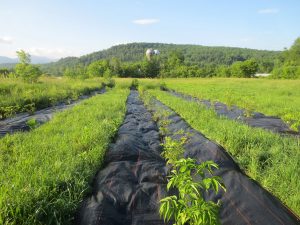
- Goals of Tarping: John has now sold The Farm Between, but prior to doing so he successfully used landscape fabric tarps for no-till establishment of perennial crops into sod or fields previously used for annual production. For fruits like elderberry, they’d dig a hole and plant directly into the sod or un-tilled field, then take two pieces of landscape fabric and lay them on either side of the crop row with the edges meeting alongside the planted perennials. This allowed for several (typically 3 feet) of weed control on either side of the row, with the ability to easily remove tarps to apply amendments. After a few years of the excellent weed control enabled by the fabric, they’d transition to natural mulch (cardboard and woodchips). Periodically when the quackgrass crept back in, they’d re-apply the landscape fabric as needed to maintain weed control.
- Early Uses of Tarps: Before they started doing this, the weed pressure in their perennials plantings was unbearable. They would hand weed every season, and weed competition still consistently harmed their crops. They saw immediate benefits from this use of landscape fabric.
- Current Crops and Systems: During the years they used this practice it allowed the farm to become more profitable, reduced their labor costs, and made life a lot easier.
Tarp Details and Management
- Years Tarping: 10 years.
- Tarp Material: Woven landscape fabric.
- Source of the Tarps and Lifespan: John sourced new landscape fabric from Gemplers, and used the fabric for many years – it would typically last for at least seven years of use.
- Tarp Size: They would purchase 6’ wide fabric and create two 3’ wide lengths by “cutting” it with a propane torch; John said, “it’s important to know that you can’t just cut this stuff with a knife or scissors, it becomes confetti — you need to melt it.”
- Securing Method: 5 or 7-inch metal staples.
- Tarp Storage: For many crops including Aronia, elderberry, raspberries, and blueberries they would leave the fabric out in the field over the winter. When fabric would start to get weedy from being in one place too long they’d rip it up, flip it over, or move it around. An exception was in crops susceptible to vole damage like young apples. Voles love it under landscape fabric, so in susceptible crops, they would fold up the fabric and store it for the winter. They would not bother cleaning it and would leave the staples in so it was easy to roll back out and re-secure next year.
[With landscape fabric] it’s important to know that you can’t just cut this stuff with a knife or scissors, it becomes confetti — you need to melt it.
Specific Applications and Management
- Fitting Tarps into the Rotation: This application is used in the transition to perennial crops. Here John gives an example of transitioning a field to blueberry production.
- Pre-tarping Practices: If they were going to start a new blueberry field, they would first soil test and adjust pH as necessary. If the field had previously been in annual production, they’d put in a nitrogen-fixing cover crop and then kill it, and direct-plant into the residue.
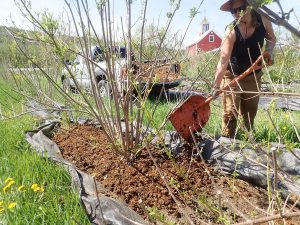
Amendments Critical to the System: A benefit of this system is the way the fabric meets along the crop rows, which allows the farmer to lift it up, put compost in, and put the edges back together as needed. Other folks cutting holes in fabric to plant into don’t have the same access to apply amendments.
Takeaways, Mistakes, and Big Wins
- Failures, Unintended Consequences, and Adjustments: One major failure was trying to mulch over the landscape fabric. They attempted this because they didn’t like the aesthetics of the plastic, but it just invited the quackgrass to move in and “created a mess.”
- Measures of Success: In addition to labor savings, improved weed management, and retention of soil moisture so that irrigation was not needed in their perennials, they saw improvements to soil health and biological activity. In comparison to the “beating” their soils experienced when in annual production with tillage, John saw switching to perennials and no-till practices as a game changer for soil health.
- Future Experimentation and Adjustments: They made their own compost from horse manure, woodchips, and food scraps from local schools and businesses. John really liked ramial woodchips as a mulch as well.
- Lessons Learned: The biggest lesson learned was don’t mulch over the fabric. Other key lessons: burn the fabric rather than cutting it with scissors, and in susceptible crops, “don’t leave it out all winter for the voles to have a party.”
- Advice for New Tarpers: “Try it out!” In the long run, taking time to experiment with things that might be able to improve your system can be really helpful.
One major failure was trying to mulch over the landscape fabric. They attempted this because they didn’t like the aesthetics of the plastic, but it just invited the quackgrass to move in and created a mess.
Links are provided purely for educational purposes. No responsibility is assumed for any content on the linked sites.


